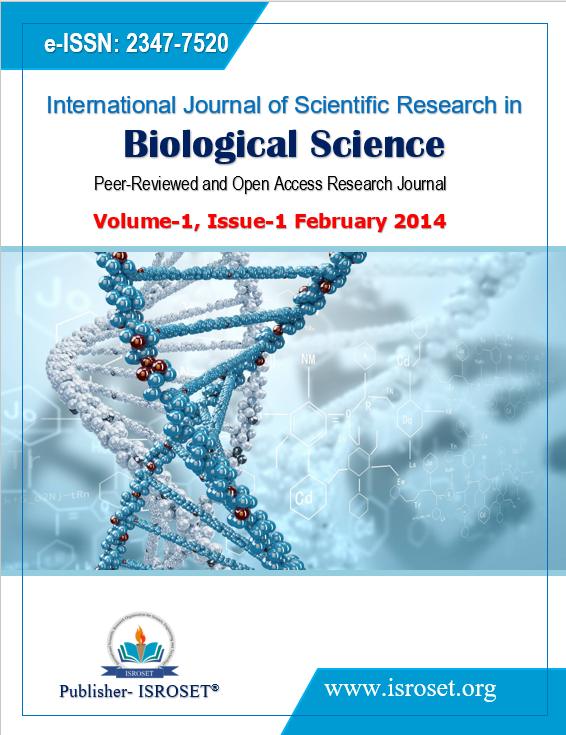Detection of Single Nucleotide Polymorphism by T-ARMS PCR of Cross Bred Cattle Karan Fries for A1, A2 Beta Casein Types
Keywords:
Casein Genes, Karan Fries Cattle, Genetic Polymorphism, T-ARMS PCR, SNP’sAbstract
“Detection of Single nucleotide Polymorphism by T-ARMS PCR of cross bred cattle Karan Fries for A1, A2 beta casein types” to distinguish between A1 and A2 type containing beta-casein and genotyping of hundred Karan Fries cross breed cattle. Casein is the main milk protein where it accounts for 80% of bovine milk protein and contains four fractions (alpha S1-CN, alpha S2-CN, beta-CN and k-CN). Beta casein contributes 25-35% of milk protein and many variants are reported (A1, A2, A3, B, C, D, E, F, G, H1, H2 and I) in different breeds of cattle. The beta casein variants A1 and A2 differs in the 67th amino acid position, the substitution of proline in A2 type with Histidine (in A1) is mainly due to a replacement of “C” nucleotide with “A” nucleotide in that corresponding nucleotide position. One hundred Karan Fries cross breed cattle were selected for genotyping of A1, A2 beta casein gene from the genomic DNA. The beta casein gene was amplified by Multiplex Tetra-Primer Amplification (T-ARMS-PCR). T-ARMS touchdown PCR and subsequent agarose gel electrophoresis could differentiate between the A1, A2 types of beta casein genes in these animals. The screening result showed three genotypes of animal in these 100 animals. The number of A2A2, A1A2 and A1A1 animals are 73, 19 and 8 respectively. The frequency of A2 and A1 alleles are 0.825 and 0.175 respectively.
References
De Noni I., 2008. Release of b-casomorphins 5 and 7 during simulated gastro-intestinal digestion of bovine b-casein variants and milk-based infant formulas. Food Chemistry. 110(4), 897-903.
Eigel, W.N., Butler, J.E., Ernstrom, C.A., Farrell, H.M., Halwarkar, V.R., Jenness, R., Whitney, R.M.,1984. Nomenclature of proteins of cow’s milk: fifth revision. J Dairy Sci 67: 1599–1631.
Elliott RB, Wasmuth HE, Bibby NJ, Hill JP, 1997.The role of beta-casein variants in the induction of insulin-dependent diabetes in the non-obese diabetic mouse and humans. In: Milk protein polymorphism.Proceedings of the IDF Seminar held in Palmerston North, New Zealand. Int Dairy Fed: 445–453.
Farrell, H.M Jr., Jimenez-Flores, R., Bleck, G.T., Brown, E.M., Butler, J.E., Creamer, L.K. ,2004. Nomenclature of the proteins of cows' milk sixth revision. J Dairy Sci. 87(6), 1641-74.
Hartwig A, Teschemacher H, Lehmann W, Gauly M, Erhardt G, 1997. Influence of genetic polymorphisms in bovine milk on the occurrence of bioactive peptides. In: Milk protein polymorphism.Proceedings of the IDF Seminar held in Palmerston North, New Zealand. Int Dairy Fed: 459–460.
Jinsmaa, Y. and Yoshikawa, M,1999. Enzymatic release of neocasomorphin and beta-casomorphinfrom bovine beta-casein. Peptides 20:957-962.
Kaminski, S., Cielinska, A., Kostyra, E. 2007. Polymorphism of bovine beta-casein and its potential effect on health. J Appl Genet 48:189–198.
.Roginski H. ,2003. Encyclopedia of dairy sciences. Academic Press, London, UK. Schopen
Saini, A.L. and Gill, R.S., 1991. Goat milk: An attractive alternate. Indian Dairyman.42: 562-564.
Sambrook, J and Russell, D. ,2001. Molecular cloning .A laboratory manual 3rd edition .Cold spring Harbor press,Cold Spring Harbour ,N,Y.
Teschemacher, H.2003. Opioid receptor ligands derived from food proteins. Curr Pharm Des 9: 1331–1344.
Downloads
Published
How to Cite
Issue
Section
License

This work is licensed under a Creative Commons Attribution 4.0 International License.
Authors contributing to this journal agree to publish their articles under the Creative Commons Attribution 4.0 International License, allowing third parties to share their work (copy, distribute, transmit) and to adapt it, under the condition that the authors are given credit and that in the event of reuse or distribution, the terms of this license are made clear.







